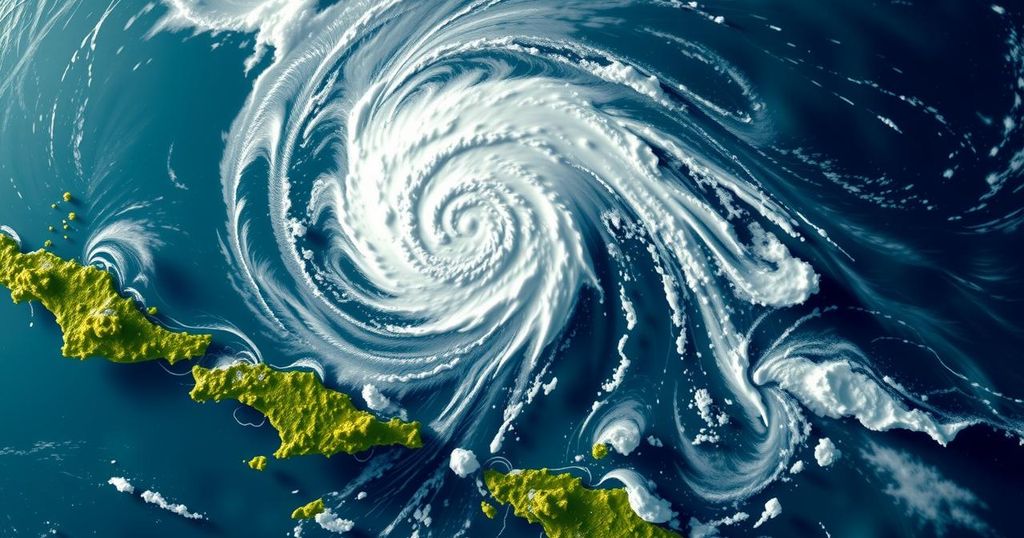Tropical Storm Oscar approached the Bahamas after making landfall as a Category 1 hurricane in Cuba, leading to six fatalities and extensive rainfall. The storm, historically the smallest recorded hurricane, surprised meteorologists with its sudden intensification. As the hurricane season progresses, Oscar is one of numerous significant storms, with potential for more to follow.
Tropical Storm Oscar advanced towards the Bahamas on Tuesday following its landfall in Cuba as a Category 1 hurricane. The storm resulted in the tragic loss of at least six lives due to its devastating impact, compounded by significant rainfall in a region already grappling with a separate extensive power outage. As of Tuesday morning, Oscar was located approximately 45 miles (75 kilometers) south-southeast of Long Island, Bahamas, with sustained winds of 40 mph (65 kph) and proceeding north-northeastward at a rate of 12 mph (19 kph), as reported by the National Hurricane Center in Miami. Currently, Oscar is defined as a minimal tropical storm, causing forecasters to anticipate between 5 to 8 inches (13 to 20 centimeters) of precipitation in certain areas of the southeastern Bahamas, leading to a tropical storm warning for the central and southeastern regions. Historically, Oscar is noted for being one of the smallest hurricanes on record, characterized by a wind field of merely 6 miles (10 kilometers). Its unexpected intensification into a hurricane took many meteorologists by surprise. Michael Lowry, a recognized hurricane specialist, commented on this anomaly, stating, “It’s not often we see a colossal failure in hurricane forecasting,” highlighting the lack of forecasting models that predicted Oscar’s transition into a hurricane. The storm has already unleashed at least 15 inches (38 centimeters) of rain across sections of eastern Cuba on Monday, presenting significant risks for flooding and landslides. The fatalities occurred in Guantánamo. Complicating the situation, Cuba is currently facing challenges in recovering from a major blackout that led to protests and stern governmental warnings against unrest. Oscar marks the 15th named storm and the 10th hurricane of the ongoing Atlantic hurricane season, which runs from June 1 to November 30. The National Oceanic and Atmospheric Administration has forecasted an above-average hurricane season due to record-high ocean temperatures, predicting between 17 and 25 named storms, including four to seven major hurricanes rated Category 3 or above. Additionally, the Pacific Ocean is currently home to Tropical Storm Kristy, located 375 miles (605 kilometers) west-southwest of Acapulco, Mexico, with wind speeds of 50 mph (85 kph), and it is anticipated to escalate to hurricane status by the evening.
The Atlantic hurricane season is a crucial period from June 1 to November 30, during which meteorologists monitor storm developments closely. Tropical Storm Oscar exemplifies the unpredictable nature of hurricanes, having transformed unexpectedly into a hurricane that caught weather experts off guard. Furthermore, the storm’s impact is exacerbated by existing challenges in regions such as Cuba, where recovery from power outages and flooding poses additional threats to public safety and infrastructure. The ongoing dispute surrounding predictions of storm development illustrates the complexities involved in meteorological forecasting.
In summary, Tropical Storm Oscar represents a critical event within the current Atlantic hurricane season, having transitioned unexpectedly from hurricane to tropical storm while causing fatalities and significant rainfall in affected areas. The situation continues to evolve as authorities track the storm’s progress and implement necessary precautions for safety in the Bahamas and beyond. With the heightened predictions for the rest of the hurricane season, vigilance remains essential.
Original Source: www.seattletimes.com







